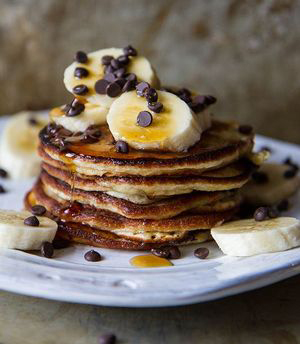Pancakes are quiet a life-saving discovery. On one of those lazy mornings when you are in no mood for the regular dosa or idli, or even the quintessential comfort food—sandwiches—light, fluffy pancakes are sure to cheer you up.
With minimal ingredients—flour, milk, eggs and butter—pancakes could easily be called one of the simplest, yet delectable, breakfast options. That, however, doesn't make them a dull option. Even the simplest pancakes come with endless possibilities of experimentation—whole wheat or plain flour, with milk or buttermilk, mashed bananas or shredded apples, and with toppings of your choice. If common images of beautifully stacked brown, crisp pancakes with a viscous golden syrup dripping off them have given us a notion that maple syrup is the ideal topping, that is not so. You can load it up with honey, fresh or roasted fruit slices, jams, or even a chocolatey Nutella spread, if you are a fan. And, if you are one of those who wish to maintain the purity of freshly-cooked pancakes, you could have them as such, too. Standard recipes may not demand that hint of spice in your sweet pancakes, but a pinch of cinnamon powder or even cardamom can do wonders to subtly elevate the flavour.
 via Pinterest
via Pinterest
If you thought that this quick comfort food evolved as a result of our time-deprived daily madness, that's not so. Pancakes have been around for quite a long time, and have evolved over the years, across the world. In fact, a primal form of the beloved pancake has been traced back to the Neolithic age when humans ground cultivated einkorn wheat, mixed it with birds' eggs, goat's milk and poured the batter on a heated rock. Historical evidence also shows that ancient Romans and Greeks ate a dish similar to pancakes, sweetened with honey, and the Elizabethans in Britain pepped up their pancakes with spices, rosewater and sherry. The Roman Catholics in the United States traditionally ate pancakes on Shrove Tuesday, also celebrated as Pancake Day, a day before the beginning of Lent. During Lent, the Christians are expected to lead simple living and eat sparingly, and pancakes were probably the best way to finish the stored up ration of eggs, butter and milk. This also marked a last day of yummy food and merry making before the grim period of Lent, mandated by the Church.
All said, however easy it may seem to mix the simple batter, pour it on a hot girdle and flip it, pancake making is an art; an acquired skill. Achieving the perfect pancake is not a simple feat—sometimes they fall apart as you flip them, or they are overdone, or do not come out in perfect circles. But if you watch out for these common mistakes, and practice them well enough, you can cook the perfect pancakes in your kitchen this weekend.
1. The batter: It is always about the batter, isn't it. But how can such can go wrong with such a simple batter? The secret to the right batter lies in how you mix it. When you mix the wet and dry ingredients in the batter, lumps will form. Mix well to avoid lumps. And we are tempted to keep mixing it over and over again to make it smooth. Don't! Resist that temptation. In fact, as you mix it for a longer time, the gluten in the flour starts to develop. Over mixing the pancakes results in chewy pancakes, not those fluffy ones you dream of. Also, keep a check on consistency. It should not be as loose as a dosa batter, but a slightly thick, slightly lumpy batter.
2. Give it time: Once you are done with the batter, do not be in a hurry to toss it on the girdle. Let it sit for a few minutes for the flavours to come through and the butter to sink in. No matter how hungry you are, do not compromise on this little step. When you let it wait, the gluten that was formed also relaxes a bit.
3. The pan: This is the trickiest part. Though there are cute pancake pans available in the market, the usual non-stick pan at home will work. Slightly grease it with butter, but take care not to burn the butter. Give your pan time to heat evenly. If not, the first pancake might become a disaster—too soggy to be flipped successfully. Nothing like those delicate, crisp-around-the-edges, soft inside pancakes. This happens because you haven't let the pan get hot enough. After you have tried, and tossed one or two successful pancakes, lower the heat and allow the pan to cool down a bit. The pan needs to be hot, right, but an overheated pan can just burn the exteriors, leaving a raw, gooey inside. Phew!!
4. Flipping 'em: Once the bubbles begin to appear, you might be tempted to flip them. Nope. Hold it. Ensure that the other side has turned brown, then flip. Also remember, pancakes should be flipped just once. Do not keep flipping them over and over again and kill the fluffy texture. So, wait and flip them at the right time.
Serve them hot, and keep practising. After all, practice maketh a man, and pancakes better.







